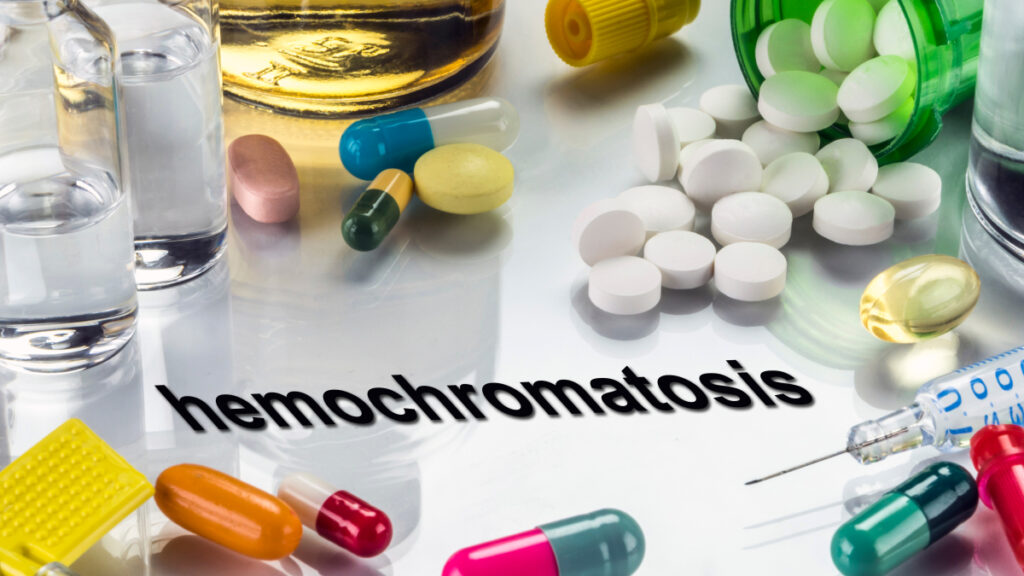
OVERVIEW
Hemochromatosis is a disease condition characterised by an excess amount of iron in the body. Hemochromatosis is also known as iron overload. In this condition, the intestine absorbs more iron than the adequate amount, which becomes toxic to the body. The excess iron is deposited on the liver, pancreas, heart, pituitary gland, and other organs, causing damage to the organs.
The body does not normally excrete excess iron, it is usually stored. In hemochromatosis, iron surpasses the storage ability of the body, leading to increased iron levels in the blood and storage organs.
Hemochromatosis is hereditary and is known as hereditary hemochromatosis. People with the gene usually develop symptoms later in life. There is no cure for hereditary hemochromatosis. Proper management can reduce symptoms and prevent organ damage.
KEY FACTS
- Hemochromatosis, also known as iron overload, tends to affect more males than females. Females absorb less iron and lose more through the menstrual cycle and child delivery.
- Hemochromatosis is common among Northern Europeans. It is rare among Blacks and Hispanics.
- Some people with hereditary hemochromatosis do not show symptoms of the disease. The reason is still under study. Symptoms of hemochromatosis are weakness, abdominal pain, joint pain, etc.
- There is no cure for hemochromatosis. A person needs to see a doctor immediately after symptoms develop.
TYPES
There are four types of hereditary hemochromatosis based on the onset of symptoms and mode of inheritance. These types are known as primary hemochromatosis because they are inherited.
- Type 1 hereditary hemochromatosis: It is also called classic hereditary hemochromatosis and is the most common type of hemochromatosis. The onset of symptoms is during adulthood. Classic hereditary hemochromatosis undergoes an autosomal recessive pattern of inheritance.
- Type 2 hereditary hemochromatosis: Type 2 hereditary hemochromatosis is also called juvenile hemochromatosis. Symptoms appear in early childhood. It is very severe, and if left unchecked, death could result before 30 years of age. Juvenile hereditary hemochromatosis goes through an autosomal recessive pattern of inheritance.
- Type 3 hereditary hemochromatosis: It goes through an autosomal recessive pattern of inheritance. The age of onset of symptoms is between childhood and adulthood.
- Type 4 hereditary hemochromatosis: Symptoms appear during adulthood. An autosomal dominant pattern of inheritance occurs here.
There is a type of iron overload that is not inherited. It is called secondary hemochromatosis or acquired hemochromatosis. This group develops due to the presence of other disease conditions that lead to iron build-up.
SYMPTOMS
Hemochromatosis symptoms are not always apparent. Most people with hemochromatosis develop symptoms later in life, and some do not show signs.
Men develop symptoms from 30 years of age, while women develop symptoms typically after menopause. The reason is that the monthly cycle and delivery periods will help women reduce the excess iron.
Hemochromatosis symptoms usually overlap with other disease symptoms, especially at the early stage. Observable symptoms include:
- Joint pain, especially in the joints of the index and middle finger
- Tiredness
- Abdominal pain
- Drastic weight loss
- Loss of libido (sex drive)
- Skin colour darkens
- Heart flutter (irregular heartbeat)
- Memory fog
DIAGNOSIS
Diagnosis of hemochromatosis can be a difficult task because the symptoms of the disease are similar to other conditions.
The doctor will take a good history of the suspected case. A detailed account of the disease helps the doctor in his diagnosis.
The doctor will also order various tests to confirm his diagnosis. These tests include
- Transferrin saturation: Transferrin is the protein that transports iron in the body. The saturation levels of transferrin tell if there is iron overload or not.
- Serum ferritin: Ferritin is the storage protein for iron. In iron overload, serum ferritin levels increase, indicating hemochromatosis disease.
- Liver biopsy: The liver is the primary storage site for iron. The doctor takes a portion of the liver to check for any damage due to iron overload.
- Genetic testing: Genetic testing shows if an individual’s hemochromatosis gene is present.
- M.R.I.: An M.R.I. scan shows organ morphology. It will help the doctor ascertain organ damage.
CAUSES
The inheritance of a defective gene usually causes hemochromatosis. The inheritance pattern is autosomal recessive, which means that a person has to inherit copies of the defective gene from both parents, to come down with the disease condition.
The H.F.E. gene is the gene responsible for controlling iron absorption. Hepcidin works hand in hand with the H.F.E. to regulate iron absorption. Hepcidin is a hormone produced and secreted by the liver to prevent iron absorption.
Mutations in the H.F.E. gene and hepcidin protein will cause hereditary hemochromatosis. The body will no longer be able to regulate iron absorption, causing iron levels to elevate to toxic levels.
Iron overload can occur due to certain underlying conditions. In this case, it is called secondary hemochromatosis. Causes of secondary hemochromatosis include
- Frequent blood transfusion
- Anaemia
- Iron medications (injection or pills)
- Vitamin C intake can increase
- Excessive alcohol consumption
- Liver disease
COMPLICATIONS
If hemochromatosis is left unchecked, several complications can arise. These complications include
- Diabetes
- Liver cirrhosis, which can lead to liver cancer
- Congestive heart failure (CHF)
- Cardiac arrhythmia (irregular heart rhythm)
- Arthritis
- Erectile dysfunction in males
- Altered menstrual cycle in females
- Skin colour changes to bronze or grey.
PREVENTION
Hereditary hemochromatosis cannot be prevented. Prompt detection and proper management will prevent complications.
For secondary hemochromatosis, specific measures help prevent it. These measures include:
- Reduction in alcohol intake
- Proper management of disease conditions puts a person at risk of secondary hemochromatosis.
- Taking iron medications only when necessary
- Monitoring patients on regular blood transfusions to watch for and prevent iron accumulation.
TYPICAL TREATMENTS
Dietary modifications and other procedures are essential in the management of hemochromatosis. The typical treatment plan includes the following:
- Dietary modifications: A person with hemochromatosis should avoid foods containing high amounts of iron. Such a person should avoid undercooked food, as it may contain infection-causing bacteria that will worsen the disease.
- Iron chelation therapy: Certain drugs are given to patients with hemochromatosis to help their bodies excrete iron. Iron excretion is either through urine or faeces. Deferasirox and deferoxamine are examples of iron-chelating medications.
- Phlebotomy: The blood of a person with hemochromatosis drains through a needle and tube. Excess iron is removed together with the blood.
- Treatment of underlying conditions: Secondary hemochromatosis caused by other diseases can be handled by treating the underlying disease.
CONCLUSION
Hemochromatosis, also known as iron overload, is usually inherited, called hereditary hemochromatosis. It is the build-up of iron within the body causing damage to various organs like the liver, pancreas, joints etc.
Hemochromatosis can either be primary hemochromatosis, referring to the inherited group, or secondary hemochromatosis, referring to those that occur because of an existing disease.
Hemochromatosis symptoms are most times present in adulthood. Early detection and management can help prevent organ damage.
MOST COMMON






